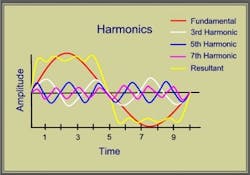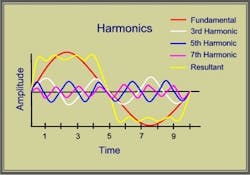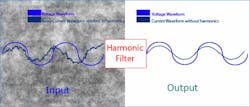One of the most often mentioned and misunderstood power quality issues we see with commercial, industrial, and power-generating electrical equipment is harmonics. Since it’s impossible to explain the theory of harmonics, the causes of harmonic issues, how to identify and meter harmonics, and offer solutions to remedy harmonic issues in one short article, this will serve as Part 1 of a multi-part series to discuss how to identify, monitor, diagnose, and deal with harmonics in large electrical systems.
Harmonics have increasingly become a concern for facilities and customers, given the ever-increasing number of non-linear and power electronic switching equipment being placed on electrical systems. The types of equipment that can create problems include:
- Uninterruptible power supplies (UPSs)
- Variable-frequency drives (VFDs)
- Computers, PLCs, etc.
Identifying and correcting harmonics and other power quality problems can lower energy costs and extend the useful life of electrical equipment. This occurs because harmonics can create uneven heating in electrical equipment, conductors, motors, etc. Simply put, harmonics are currents or voltages with frequencies that are integer multiples of the fundamental power frequency, which in the United States is 60 Hz. When waveforms deviate from a sinewave shape, they contain harmonics. Harmonics can best be described as the shape or characteristics of a voltage or current waveform relative to its fundamental (or base) frequency (Fig. 1).
Next month, we’ll focus on how to identify harmonics. Check out last month's column, "When Is the Power Quality Issue Not the Issue?" for more power quality content.
David Colombo, P.E. is a professional engineer located in Massachusetts, and the owner and principal of Power Engineers, LLC, a design, engineering, and consulting firm. He has more than 30 years in the electrical engineering and construction industry and is involved with the design of utility substation & distribution infrastructure, large-scale renewable energy projects, and commercial / industrial power systems. He specializes in the areas of medium-voltage design, power distribution, protection, metering, power quality, power studies, and arc flash analysis. He also provides owner’s engineering support for developers, EPC contractors, and project owners. Prior to starting Power Engineers, LLC and being an engineering consultant, he was a utility distribution supervising engineer. He holds a bachelor of science degree in electrical engineering from Worcester Polytechnic Institute (WPI) and a master of engineering degree in electric power engineering from Rensselaer Polytechnic Institute (RPI). He is a registered professional engineer in 13 states.
About the Author

David Colombo
David Colombo, P.E. is a Professional Engineer located in Massachusetts, and the owner and principal of Power Engineers, LLC, a design, engineering and consulting firm. He has over 30 years in the electrical engineering and construction industry and is involved with the design of utility substation & distribution infrastructure, large scale renewable energy projects, and commercial / industrial power systems. He specializes in the areas of medium-voltage design, power distribution, protection, metering, power quality, power studies and, arc flash analysis. He also provides owner’s engineering support for developers, EPC contractors and project owners. Prior to starting Power Engineers, LLC and being an engineering consultant, he was a utility distribution supervising engineer. He holds a Bachelor of Science degree in Electrical Engineering from Worcester Polytechnic Institute (WPI) and a Master of Engineering degree in Electric Power Engineering from Rensselaer Polytechnic Institute (RPI). He is a Registered Professional Engineer in 13 states.


